The Footprint of Wildfires on Mediterranean Forest Ecosystem Services in Vesuvius National Park
Abstract
:1. Introduction
2. Materials and Methods
2.1. Study Area
2.2. Burn Severity and Megafire Determination
2.3. Suppression Costs
2.4. Ecosystem Services, Beneficiaries, and Categorisation
2.5. Provisioning Services
Woody Biomass
2.6. Regulation and Maintenance Services
2.6.1. Control of Erosion Rates and Habitat Restoration
2.6.2. Pollination
2.6.3. Carbon Stocks
2.7. Cultural Services
Ecotourism
2.8. Normalisation of the Economic Loss of Ecosystem Services
3. Results
3.1. Ecosystem Services
3.2. Provisioning Services
3.3. Regulation and Maintenance Ecosystem Services
3.3.1. Habitat Restoration and Mitigation of Surface Soil Erosion
3.3.2. Wild Bumblebee Pollination
3.3.3. Carbon Stocks
3.4. Cultural Ecosystem Services
Ecotourism
3.5. Spatial Distribution of ES Economic Losses
4. Discussion
4.1. From Ecology to Economics
4.2. Post-Fire Management Actions
5. Conclusions
Supplementary Materials
Author Contributions
Funding
Institutional Review Board Statement
Informed Consent Statement
Acknowledgments
Conflicts of Interest
References
- Bond, W.J.; van Wilgen, B.W. Fire and Plants, 1st ed.; Chapman & Hall: Dordrecht, The Netherlands, 1996. [Google Scholar] [CrossRef]
- Pausas, J.G.; Llovet, J.; Rodrigo, A.; Vallejo, V.R. Are wildfires a disaster in the Mediterranean basin?—A review. Int. J. Wildland Fire 2008, 17, 713–723. [Google Scholar] [CrossRef]
- San-Miguel-Ayanz, J.; Durrant, T.; Boca, R.; Libertà, G.; Branco, A.; Rigo, D.D.; Ferrari, D.; Maianti, P.; Vivancos, T.A.; Costa, H.; et al. Forest Fires in Europe, Middle East and North Africa 2017; EUR 29318 EN; Publications Office of the European Union: Luxembourg, 2018.
- Viegas, D.X. Wildfires in Portugal. Fire Res. 2018, 2, 52. [Google Scholar] [CrossRef]
- White, P.S.; Pickett, S.T.A. (Eds.) Natural Disturbance and Patch Dynamics: An Introduction. In The Ecology of Natural Disturbances and Patch Dynamics; Academic Press, Inc.: Orlando, FL, USA, 1985; pp. 3–13. [Google Scholar] [CrossRef]
- Holmes, T.P.; Prestemon, J.P.; Abt, K.L. An Introduction to the Economics of Forest Disturbance. In The Economics of Forest Disturbances. Forestry Sciences; Holmes, T.P., Prestemon, J.P., Abt, K.L., Eds.; Springer: Dordrecht, The Netherlands, 2008; Volume 79, pp. 3–14. [Google Scholar] [CrossRef]
- Keeley, J.E.; Bond, W.J.; Bradstock, R.A.; Pausas, J.G.; Rundel, P.W. Fire in Mediterranean Ecosystems: Ecology, Evolution and Management; Cambridge University Press: Cambridge, UK, 2012. [Google Scholar] [CrossRef]
- Turner, M.G. Disturbance and landscape dynamics in a changing world. Ecology 2010, 91, 2833–2849. [Google Scholar] [CrossRef] [PubMed] [Green Version]
- Pyne, S.J. Megaburning: The Meaning of Megafires and the Means of the Management. In Proceedings of the Wildfire 2007–4th International Wildland Fire Conference, Sevilla, Spain, 13–17 May 2007. [Google Scholar]
- Tedim, F.; Leone, V.; Amraoui, M.; Bouillon, C.; Coughlan, M.R.; Delogu, G.M.; Fernandes, P.M.; Ferreira, C.; McCaffrey, S.; McGee, T.K.; et al. Defining Extreme Wildfire Events: Difficulties, Challenges, and Impacts. Fire 2018, 1, 9. [Google Scholar] [CrossRef] [Green Version]
- Mandle, L.; Shields-Estrada, A.; Chaplin-Kramer, R.; Mitchell, M.G.E.; Bremer, L.L.; Gourevitch, J.D.; Hawthorne, P.; Johnson, J.A.; Robinson, B.E.; Smith, J.R.; et al. Increasing decision relevance of ecosystem service science. Nat. Sustain. 2020, 4, 161–169. [Google Scholar] [CrossRef]
- Costanza, R.; de Groot, R.; Sutton, P.; van der Ploeg, S.; Anderson, S.J.; Kubiszewski, I.; Farber, S.; Turner, R.K. Changes in the global value of ecosystem services. Glob. Environ. Chang. 2014, 26, 152–158. [Google Scholar] [CrossRef]
- Costanza, R.; D’Arge, R.; de Groot, R.; Farber, S.; Grasso, M.; Hannon, B.; Limburg, K.; Naeem, S.; O’Neill, R.V.; Paruelo, J.M.; et al. The value of ecosystem services: Putting the issues in perspective. Ecol. Econ. 1998, 25, 67–72. [Google Scholar] [CrossRef]
- Costanza, R.; D’Arge, R.; de Groot, R.; Farber, S.; Grasso, M.; Hannon, B.; Limburg, K.; Naeem, S.; O’Neill, R.V.; Paruelo, J.; et al. The value of the world’s ecosystem services and natural capital. Nature 1997, 387, 253–260. [Google Scholar] [CrossRef]
- Farber, S.C.; Costanza, R.; Wilson, M.A. Economic and ecological concepts for valuing ecosystem services. Ecol. Econ. 2002, 41, 375–392. [Google Scholar] [CrossRef]
- De Groot, R.S.; Alkemade, R.; Braat, L.; Hein, L.; Willemen, L. Challenges in integrating the concept of ecosystem services and values in landscape planning, management and decision making. Ecol. Complex. 2010, 7, 260–272. [Google Scholar] [CrossRef]
- Christie, M.; Fazey, I.; Cooper, R.; Hyde, T.; Kenter, J.O. An evaluation of monetary and non-monetary techniques for assessing the importance of biodiversity and ecosystem services to people in countries with developing economies. Ecol. Econ. 2012, 83, 67–78. [Google Scholar] [CrossRef]
- Doerr, S.H.; Santín, C. Global trends in wildfire and its impacts: Perceptions versus realities in a changing world. Philos. Trans. R. Soc. B Biol. Sci. 2016, 371, 20150345. [Google Scholar] [CrossRef]
- Pliscoff, P.; Folchi, M.; Aliste, E.; Cea, D.; Simonetti, J.A. Chile mega-fire 2017: An analysis of social representation of forest plantation territory. Appl. Geogr. 2020, 119, 102226. [Google Scholar] [CrossRef]
- Yell, S. ‘Breakfast is Now Tea, Toast and Tissues’: Affect and the Media Coverage of Bushfires. Media Int. Aust. 2010, 137, 109–119. [Google Scholar] [CrossRef]
- Pausas, J.G.; Keeley, J.E. Wildfires as an ecosystem service. Front. Ecol. Environ. 2019, 17, 289–295. [Google Scholar] [CrossRef] [Green Version]
- DE Natale, G.; Troise, C.; Pingue, F.; Mastrolorenzo, G.; Pappalardo, L. The Somma–Vesuvius volcano (Southern Italy): Structure, dynamics and hazard evaluation. Earth-Sci. Rev. 2006, 74, 73–111. [Google Scholar] [CrossRef]
- Keeley, J.E. Fire intensity, fire severity and burn severity: A brief review and suggested usage. Int. J. Wildland Fire 2009, 18, 116–126. [Google Scholar] [CrossRef]
- Saulino, L.; Rita, A.; Migliozzi, A.; Maffei, C.; Allevato, E.; Garonna, A.P.; Saracino, A. Detecting Burn Severity across Mediterranean Forest Types by Coupling Medium-Spatial Resolution Satellite Imagery and Field Data. Remote Sens. 2020, 12, 741. [Google Scholar] [CrossRef] [Green Version]
- DellaSala, D.A.; Hanson, C.T. The Ecological Importance of Mixed-Severity Fires: Nature’s Phoenix; Elsevier: New York, NY, USA, 2015. [Google Scholar] [CrossRef]
- Petrucci, B.; Borelli, R.; Gariano, S.L. Statistiche Incendi Boschivi Nei Parchi Nazionali (1997–2015); Ministero dell’Ambiente e della Tutela del Territorio e del Mare: Rome, Italy, 2016.
- Ciancio, O.; Corona, P.; Marinelli, M.; Pettenella, D. Valutazione dei Danni da Incendi Boschivi; Tipografia Coppini: Firenze, Italy, 2007. [Google Scholar]
- Haines-Young, R.; Potschin, M. Common International Classification of Ecosystem Services CICES V5.1. Guidance on the Application of the Revised Structure. 2018. Available online: www.cices.eu (accessed on 10 December 2020).
- Gregersen, H.M.; Arnold, J.E.M.; Lundgren, A.L.; Contreras-Hermosilla, A. Valuing Forests: Context, Issues and Guidelines; Food and Agriculture Organization of the United Nations (FAO): Rome, Italy, 1995. [Google Scholar]
- Merlo, M.; Croitoru, L. Valuing Mediterranean Forests: Towards Total Economic Value; Merlo, M., Croitoru, L., Eds.; CABI: Wallingford, UK, 2005. [Google Scholar] [CrossRef]
- Santorufo, L.; Memoli, V.; Panico, S.C.; Santini, G.; Barile, R.; Giarra, A.; Di Natale, G.; Trifuoggi, M.; De Marco, A.; Maisto, G. Combined Effects of Wildfire and Vegetation Cover Type on Volcanic Soil (Functions and Properties) in a Mediterranean Region: Comparison of Two Soil Quality Indices. Int. J. Environ. Res. Public Health 2021, 18, 5926. [Google Scholar] [CrossRef]
- Dixon, J.A.; Carpenter, R.A.; Fallon, L.A.; Sherman, P.B.; Manopimoke, S. Economic Analysis of the Environmental Impacts of Development Projects, 1st ed.; Routledge: London, UK, 2009; Volume 1. [Google Scholar] [CrossRef]
- Klein, A.-M.; Vaissière, B.E.; Cane, J.H.; Steffan-Dewenter, I.; Cunningham, S.A.; Kremen, C.; Tscharntke, T. Importance of pollinators in changing landscapes for world crops. Proc. R. Soc. B Biol. Sci. 2007, 274, 303–313. [Google Scholar] [CrossRef] [Green Version]
- Kremen, C.; Williams, N.M.; Aizen, M.A.; Gemmill-Herren, B.; Lebuhn, G.; Minckley, R.L.; Packer, L.; Potts, S.G.; Roulston, T.; Steffan-Dewenter, I.; et al. Pollination and other ecosystem services produced by mobile organisms: A conceptual framework for the effects of land-use change. Ecol. Lett. 2007, 10, 299–314. [Google Scholar] [CrossRef] [PubMed]
- Allsopp, M.H.; De Lange, W.J.; Veldtman, R. Valuing Insect Pollination Services with Cost of Replacement. PLoS ONE 2008, 3, e3128. [Google Scholar] [CrossRef] [PubMed]
- Aizen, M.A.; Garibaldi, L.A.; Cunningham, S.A.; Klein, A.M. How much does agriculture depend on pollinators? Lessons from long-term trends in crop production. Ann. Bot. 2009, 103, 1579–1588. [Google Scholar] [CrossRef] [PubMed]
- Losey, J.E.; Vaughan, M. The Economic Value of Ecological Services Provided by Insects. BioScience 2006, 56, 311–323. [Google Scholar] [CrossRef] [Green Version]
- Goulson, D.; Lye, G.C.; Darvill, B. Decline and Conservation of Bumble Bees. Annu. Rev. EÈntomol. 2008, 53, 191–208. [Google Scholar] [CrossRef]
- Keith, H.; Mackey, B.G.; Lindenmayer, D.B. Re-evaluation of forest biomass carbon stocks and lessons from the world’s most carbon-dense forests. Proc. Natl. Acad. Sci. USA 2009, 106, 11635–11640. [Google Scholar] [CrossRef] [Green Version]
- IPCC. Climate Change 2014: Synthesis Report. Contribution of Working Groups I, II and III to the Fifth Assessment Report of the Intergovernmental Panel on Climate Change; Core Writing Team, Pachauri, R.K., Meyer, L.A., Eds.; IPCC: Geneva, Switzerland, 2014.
- Goldammer, J.G.; Statheropoulos, M.; Andreae, M.O. Impacts of Vegetation Fire Emissions on the Environment, Human Health, and Security: A Global Perspective. In Wildland Fires and Air Pollution; Bytnerowicz, A., Arbaugh, M.J., Riebau, A.R., Andersen, Eds.; Elsevier B.V.: Amsterdam, The Netherlands, 2009; Volume 8, pp. 3–36. [Google Scholar] [CrossRef]
- IPCC. Revised Supplementary Methods and Good Practice Guidance Arising from the Kyoto Protocol; Hiraishi, T., Krug, T., Tanabe, K., Srivastava, N., Baasansuren, J., Fukuda, M., Troxler, T.G., Eds.; IPCC: Geneva, Switzerland, 2013.
- Grilli, G.; Ciolli, M.; Garegnani, G.; Geri, F.; Sacchelli, S.; Poljanec, A.; Vettorato, D.; Paletto, A. A method to assess the economic impacts of forest biomass use on ecosystem services in a National Park. Biomass Bioenergy 2017, 98, 252–263. [Google Scholar] [CrossRef] [Green Version]
- Häyhä, T.; Franzese, P.P.; Paletto, A.; Fath, B.D. Assessing, valuing, and mapping ecosystem services in Alpine forests. Ecosyst. Serv. 2015, 14, 12–23. [Google Scholar] [CrossRef]
- Howarth, R.B.; Gerst, M.D.; Borsuk, M.E. Risk mitigation and the social cost of carbon. Glob. Environ. Chang. 2014, 24, 123–131. [Google Scholar] [CrossRef]
- Van den Bijgaart, I.; Gerlagh, R.; Liski, M. A simple formula for the social cost of carbon. J. Environ. Econ. Manag. 2016, 77, 75–94. [Google Scholar] [CrossRef] [Green Version]
- Maes, J.; Liquete, C.; Teller, A.; Erhard, M.; Paracchini, M.L.; Barredo, J.I.; Grizzetti, B.; Cardoso, A.; Somma, F.; Petersen, J.-E.; et al. An indicator framework for assessing ecosystem services in support of the EU Biodiversity Strategy to 2020. Ecosyst. Serv. 2015, 17, 14–23. [Google Scholar] [CrossRef] [Green Version]
- Tedim, F.; Leone, V. The Dilemma of Wildfire Definition: What It Reveals and What It Implies. Front. For. Glob. Chang. 2020, 3, 134. [Google Scholar] [CrossRef]
- Wang, D.; Guan, D.; Zhu, S.; Mac Kinnon, M.; Geng, G.; Zhang, Q.; Zheng, H.; Lei, T.; Shao, S.; Gong, P.; et al. Economic footprint of California wildfires in 2018. Nat. Sustain. 2020, 4, 252–260. [Google Scholar] [CrossRef]
- Williams, J. Exploring the onset of high-impact mega-fires through a forest land management prism. For. Ecol. Manag. 2013, 294, 4–10. [Google Scholar] [CrossRef]
- Stephenson, C.; Handmer, J.; Betts, R. Estimating the economic, social and environmental impacts of wildfires in Australia. Environ. Hazards 2013, 12, 93–111. [Google Scholar] [CrossRef]
- Butry, D.T.; Mercer, E.D.; Prestemon, J.P.; Pye, J.M.; Holmes, T.P. What is the price of catastrophic wildfire? J. For. 2001, 99, 9–17. [Google Scholar] [CrossRef]
- Adams, M. Mega-fires, tipping points and ecosystem services: Managing forests and woodlands in an uncertain future. For. Ecol. Manag. 2013, 294, 250–261. [Google Scholar] [CrossRef]
- Costanza, R.; De Groot, R.; Braat, L.; Kubiszewski, I.; Fioramonti, L.; Sutton, P.; Farber, S.; Grasso, M. Twenty years of ecosystem services: How far have we come and how far do we still need to go? Ecosyst. Serv. 2017, 28 Pt A, 1–16. [Google Scholar] [CrossRef]
- Ekayani, M.; Nurrochmat, D.R.; Darusman, D. The role of scientists in forest fire media discourse and its potential influence for policy-agenda setting in Indonesia. For. Policy Econ. 2016, 68, 22–29. [Google Scholar] [CrossRef]
- Pausas, J.G.; Ribeiro, E.; Vallejo, R. Post-fire regeneration variability of Pinus halepensis in the eastern Iberian Peninsula. For. Ecol. Manag. 2004, 203, 251–259. [Google Scholar] [CrossRef]
- Bosso, L.; Ancillotto, L.; Smeraldo, S.; D’Arco, S.; Migliozzi, A.; Conti, P.; Russo, D. Loss of potential bat habitat following a severe wildfire: A model-based rapid assessment. Int. J. Wildland Fire 2018, 27, 756. [Google Scholar] [CrossRef] [Green Version]
- Stinca, A.; Chirico, G.B.; Incerti, G.; Bonanomi, G. Regime Shift by an Exotic Nitrogen-Fixing Shrub Mediates Plant Facilitation in Primary Succession. PLoS ONE 2015, 10, e0123128. [Google Scholar] [CrossRef] [PubMed] [Green Version]
- Castro-Díez, P.; Vaz, A.S.; Silva, J.S.; Van Loo, M.; Alonso, Á.; Aponte, C.; Bayón, Á.; Bellingham, P.J.; Chiuffo, M.C.; DiManno, N.; et al. Global effects of non-native tree species on multiple ecosystem services. Biol. Rev. 2019, 94, 1477–1501. [Google Scholar] [CrossRef] [PubMed]
- DellaSala, D.A.; Karr, J.R.; Schoennagel, T.; Perry, D.; Noss, R.F.; Lindenmayer, D.; Beschta, R.; Hutto, R.L.; Swanson, M.E.; Evans, J. Post-Fire Logging Debate Ignores Many Issues. Science 2006, 314, 51–52. [Google Scholar] [CrossRef] [PubMed] [Green Version]
- Thorn, S.; Chao, A.; Georgiev, K.B.; Müller, J.; Bässler, C.; Campbell, J.L.; Castro, J.; Chen, Y.-H.; Choi, C.-Y.; Cobb, T.P.; et al. Estimating retention benchmarks for salvage logging to protect biodiversity. Nat. Commun. 2020, 11, 4762. [Google Scholar] [CrossRef] [PubMed]
- Allevato, E.; Buonincontri, M.; Vairo, M.; Pecci, A.; Cau, M.A.; Yoneda, M.; De Simone, G.F.; Aoyagi, M.; Angelelli, C.; Matsuyama, S.; et al. Persistence of the cultural landscape in Campania (Southern Italy) before the AD 472 Vesuvius eruption: Archaeoenvironmental data. J. Archaeol. Sci. 2012, 39, 399–406. [Google Scholar] [CrossRef]
- Bartholomée, O.; Lavorel, S. Disentangling the diversity of definitions for the pollination ecosystem service and associated estimation methods. Ecol. Indic. 2019, 107, 105576. [Google Scholar] [CrossRef]
- Liss, K.N.; Mitchell, M.G.; MacDonald, G.K.; Mahajan, S.L.; Méthot, J.; Jacob, A.L.; Maguire, D.Y.; Metson, G.S.; Ziter, C.; Dancose, K.; et al. Variability in ecosystem service measurement: A pollination service case study. Front. Ecol. Environ. 2013, 11, 414–422. [Google Scholar] [CrossRef] [Green Version]
- Tol, R.S.J. The Social Cost of Carbon. Annu. Rev. Resour. Econ. 2011, 3, 419–443. [Google Scholar] [CrossRef]
- Boselli, A.; Sannino, A.; D’Emilio, M.; Wang, X.; Amoruso, S. Aerosol Characterization during the Summer 2017 Huge Fire Event on Mount Vesuvius (Italy) by Remote Sensing and In Situ Observations. Remote Sens. 2021, 13, 2001. [Google Scholar] [CrossRef]
- Castagna, J.; Senatore, A.; Bencardino, M.; D’Amore, F.; Sprovieri, F.; Pirrone, N.; Mendicino, G. Multiscale assessment of the impact on air quality of an intense wildfire season in southern Italy. Sci. Total Environ. 2020, 761, 143271. [Google Scholar] [CrossRef]
- Mazzoleni, S.; Ricciardi, M. Primary Succession on the Cone of Vesuvius. In Primary Succession on Land; Miles, J., Walton, D.W.H., Eds.; Special Publication Series of the British Ecological Society, 12; Blackwell Scientific Publications: Oxford, UK, 1993; pp. 101–112. [Google Scholar]
- Milcu, A.I.; Hanspach, J.; Abson, D.; Fischer, J. Cultural Ecosystem Services: A Literature Review and Prospects for Future Research. Ecol. Soc. 2013, 18, 44. [Google Scholar] [CrossRef] [Green Version]
- Vallejo, V.R.; Allen, E.B.; Aronson, J.; Pausas, J.G.; Cortina, J.; Gutiérrez, J.R. Restoration Ecology: The New Frontier. In Restoration Ecology: The New Frontier; Van Andel, J., Aronson, J., Eds.; Blackwell Publishing Ltd.: Oxford, UK, 2012; pp. 130–144. [Google Scholar]
- Wittenberg, L.; van der Wal, H.; Keesstra, S.; Tessler, N. Post-fire management treatment effects on soil properties and burned area restoration in a wildland-urban interface, Haifa Fire case study. Sci. Total Environ. 2019, 716, 135190. [Google Scholar] [CrossRef]
- DeBano, L.F.; Neary, D.G.; Folliott, P.F. Fire Effect on Soil and Other Ecosystem Resources; John Wiley & Sons, Ltd.: New York, NY, USA, 1998. [Google Scholar]
- Inbar, A.; Lado, M.; Sternberg, M.; Tenau, H.; Ben-Hur, M. Forest fire effects on soil chemical and physicochemical properties, infiltration, runoff, and erosion in a semiarid Mediterranean region. Geoderma 2014, 221–222, 131–138. [Google Scholar] [CrossRef]
- Santorufo, L.; Memoli, V.; Panico, S.C.; Santini, G.; Barile, R.; Di Natale, G.; Trifuoggi, M.; De Marco, A.; Maisto, G. Early post-fire changes in properties of Andosols within a Mediterranean area. Geoderma 2021, 394, 115016. [Google Scholar] [CrossRef]
- Lovreglio, R.; Giadrossich, F.; Scotti, R.; Murgia, I.; Tardío, G.; Mickovski, S.B.; García-Rodríguez, J.L. Observations on different post-fire bio-engineering interventions and vegetation response in a Pinus canariensis C. Sm. forest. Ann. Silvic. Res. 2020, 45, 76–82. [Google Scholar] [CrossRef]
- IPCC. Climate Change 2021: The Physical Science Basis. Contribution of Working Group I to the Sixth Assessment Report of the Intergovernmental Panel on Climate Change; Masson-Delmotte, V., Zhai, P., Pirani, A., Connors, S.L., Péan, C., Berger, S., Caud, N., Chen, Y., Goldfarb, L., Gomis, M.I., et al., Eds.; Cambridge University Press: Cambridge, UK, 2021; in press.
- Mouillot, F.; Rambal, S.; Joffre, R. Simulating climate change impacts on fire frequency and vegetation dynamics in a Mediterranean-type ecosystem. Glob. Chang. Biol. 2002, 8, 423–437. [Google Scholar] [CrossRef]
- Pausas, J.G.; Keeley, J.E. A Burning Story: The Role of Fire in the History of Life. BioScience 2009, 59, 593–601. [Google Scholar] [CrossRef] [Green Version]
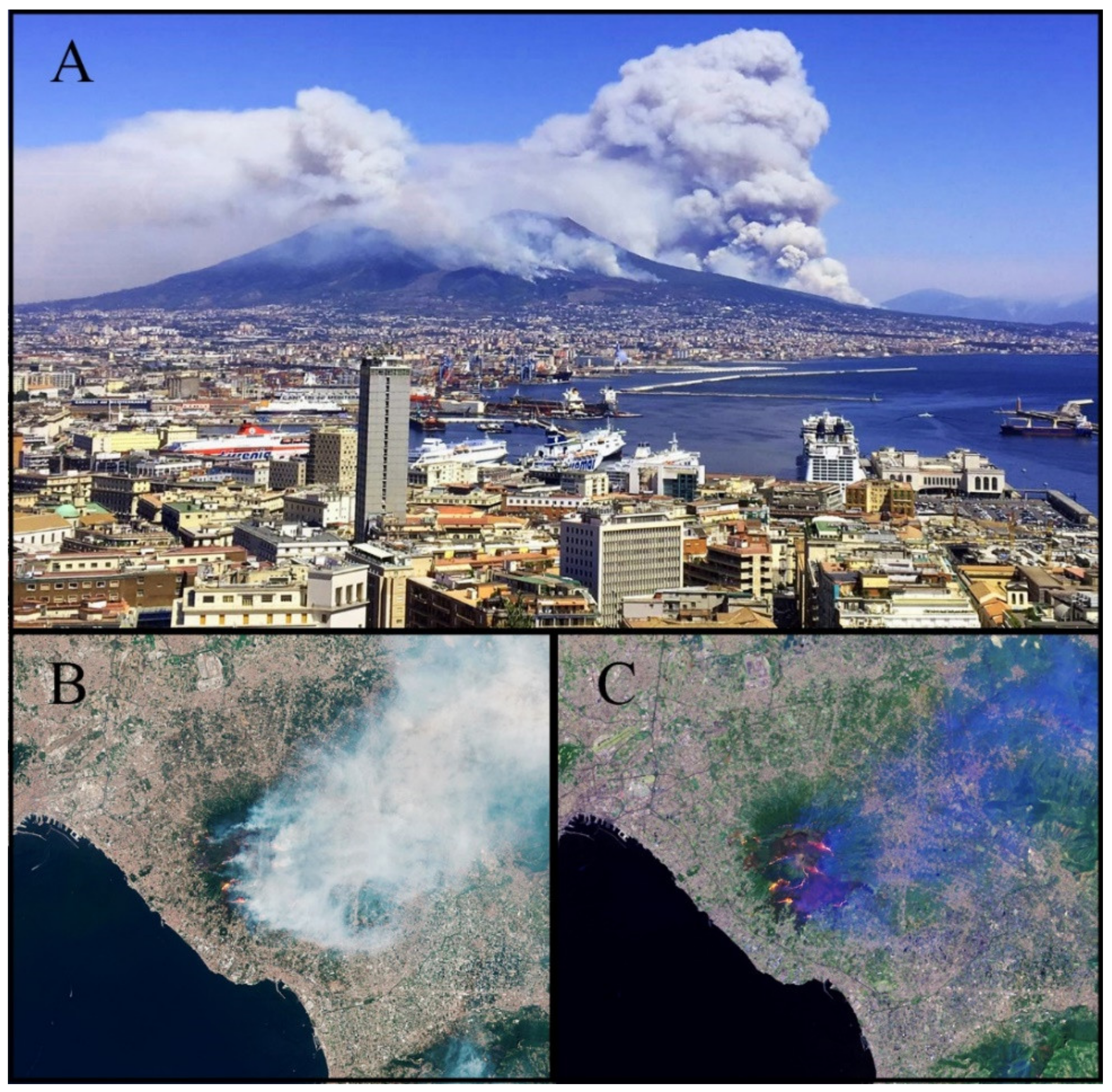
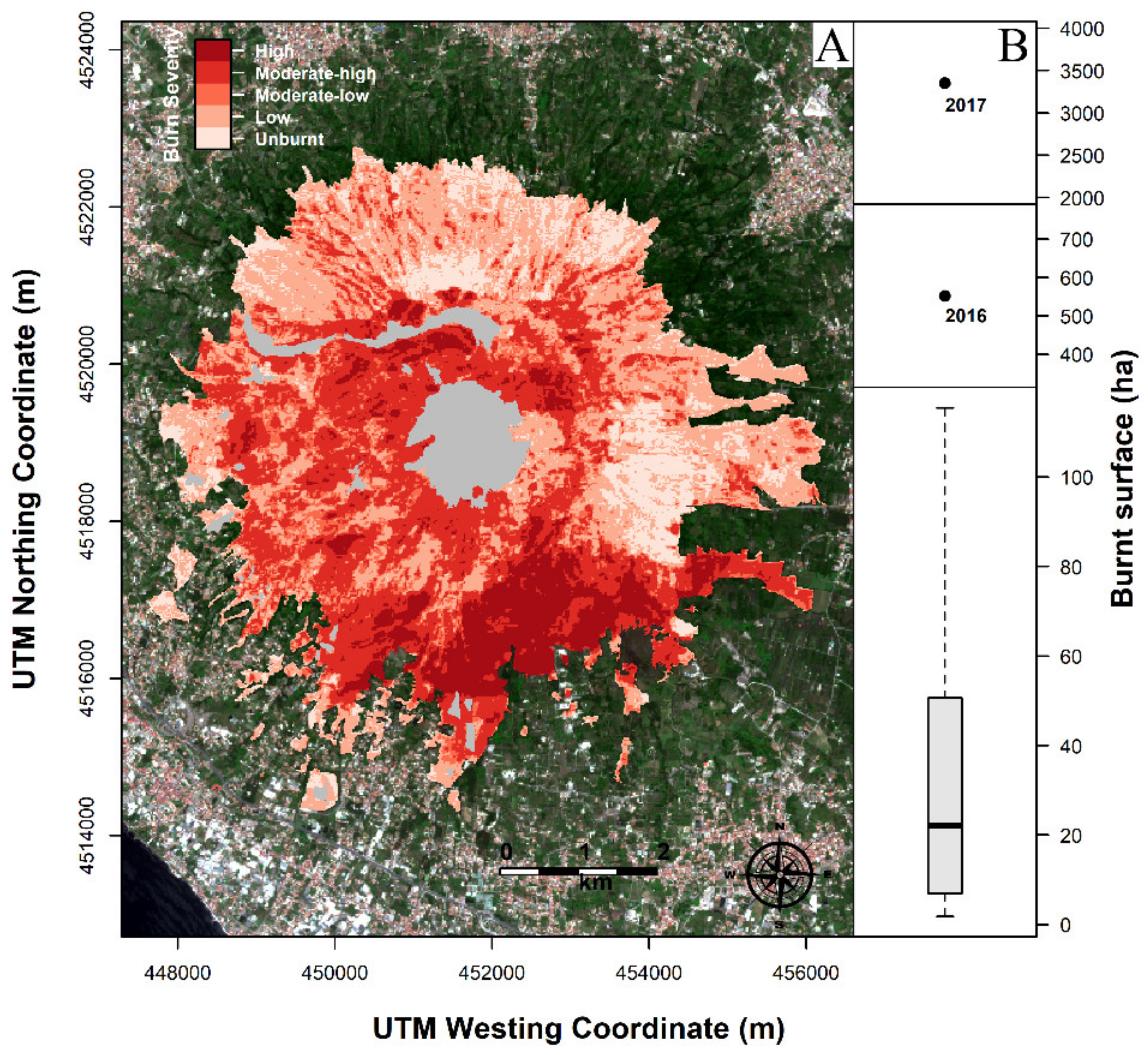
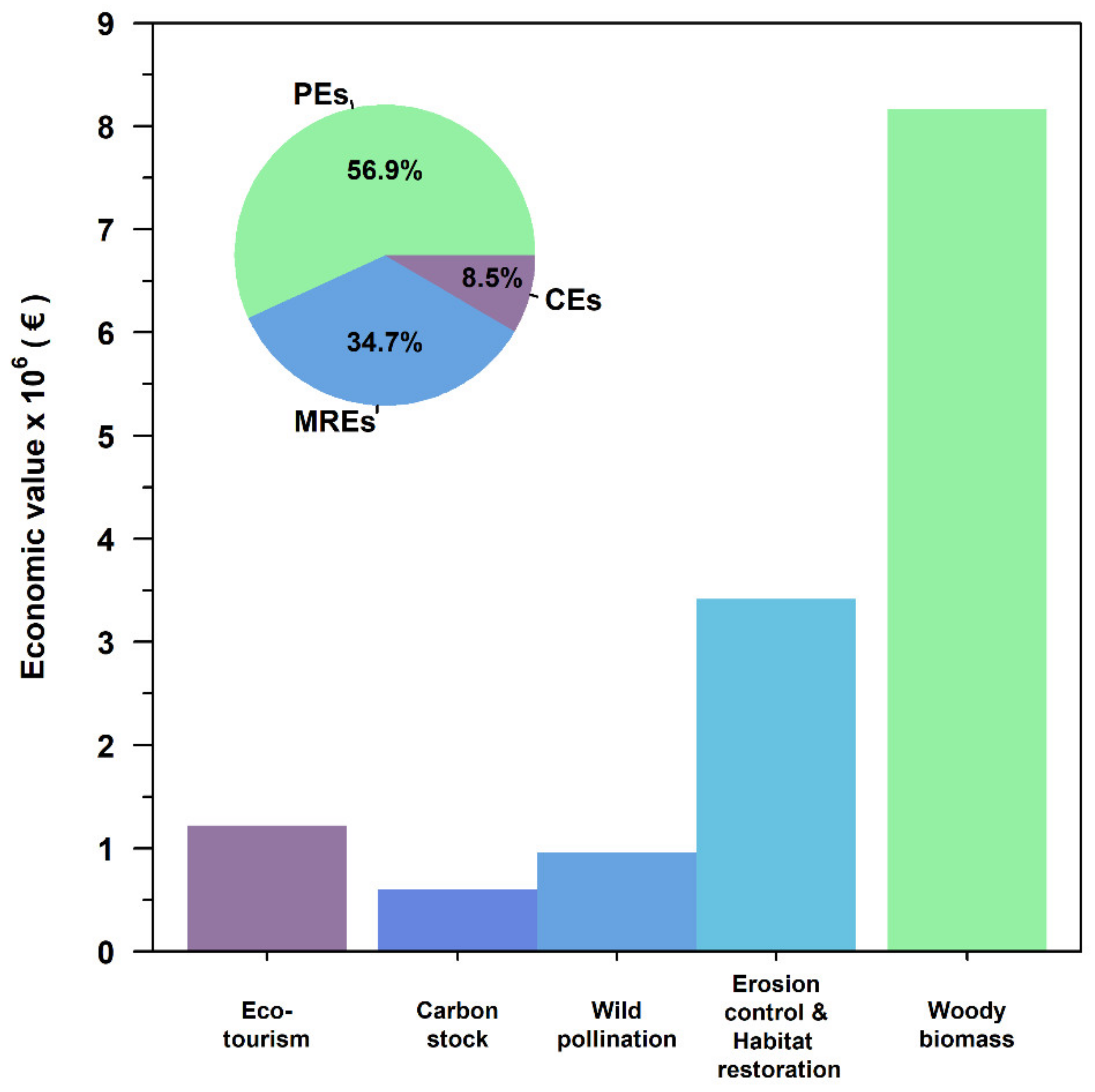
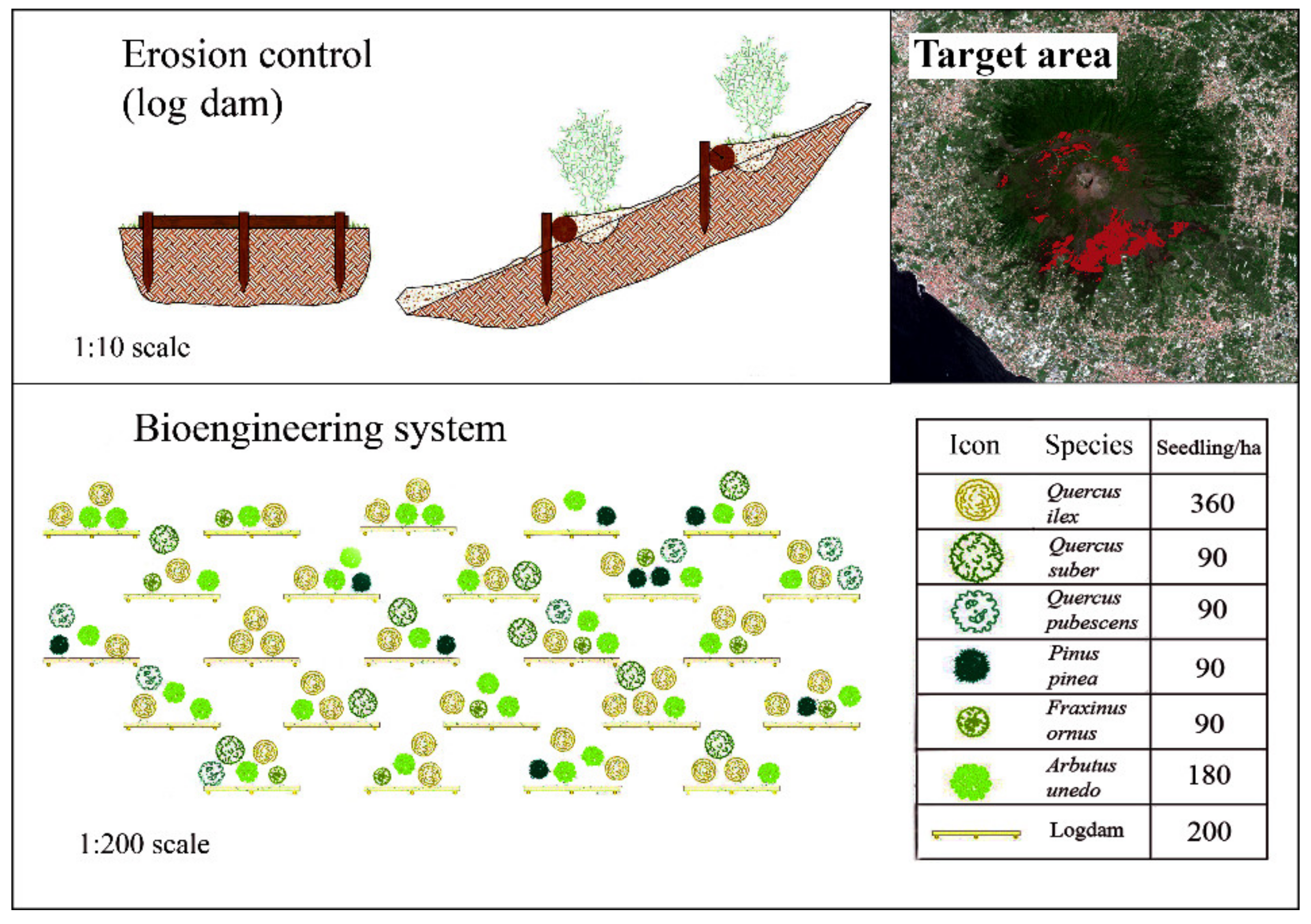
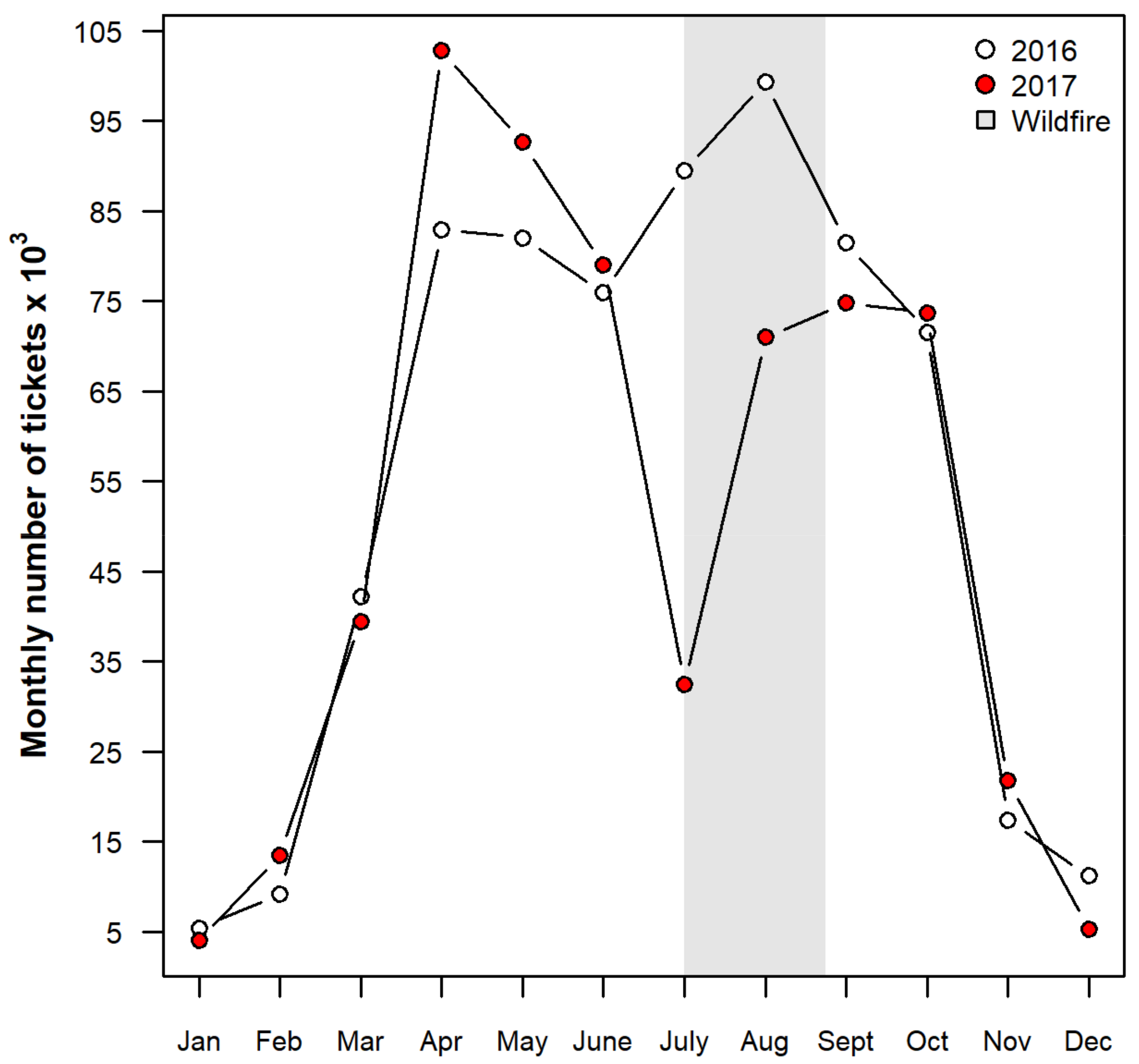
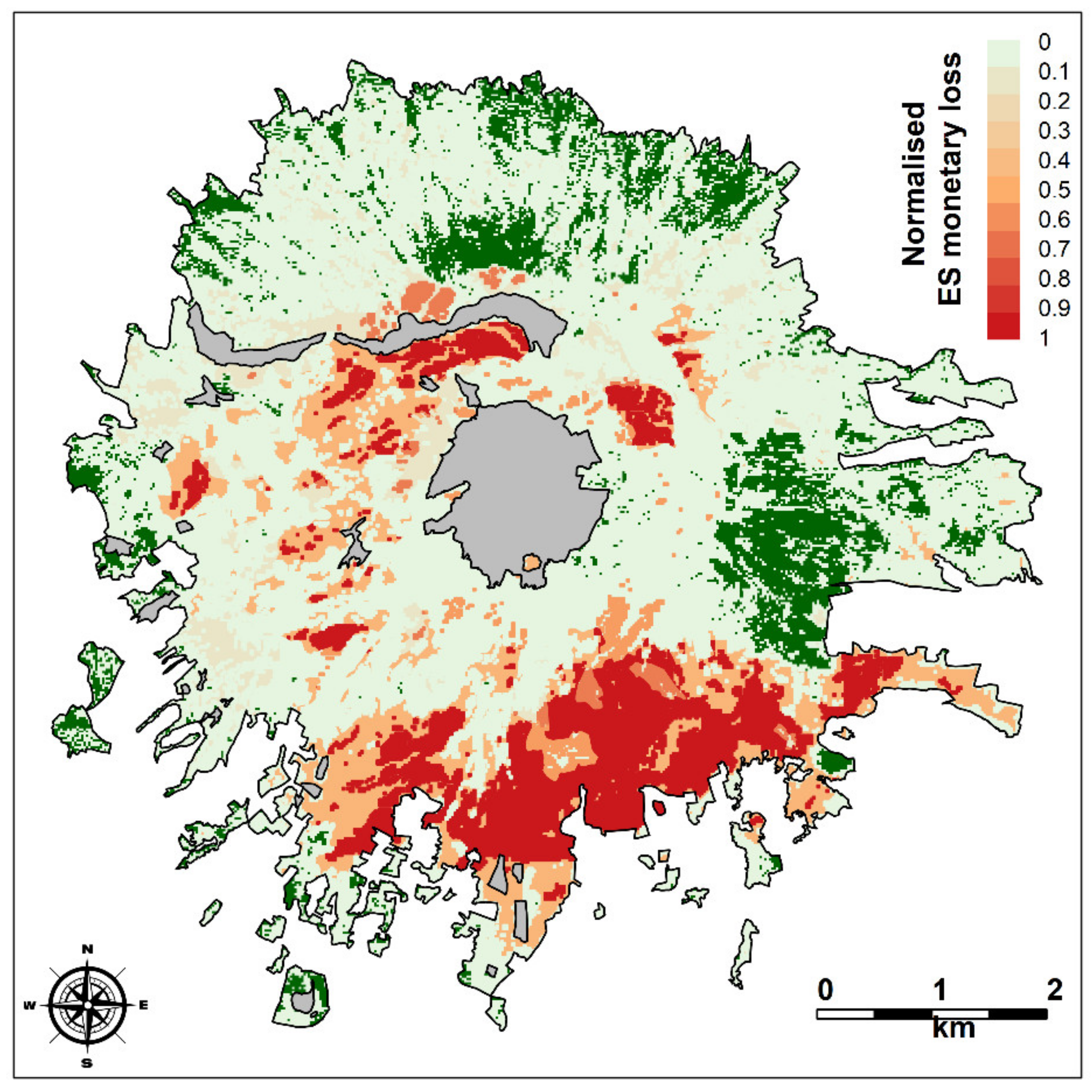
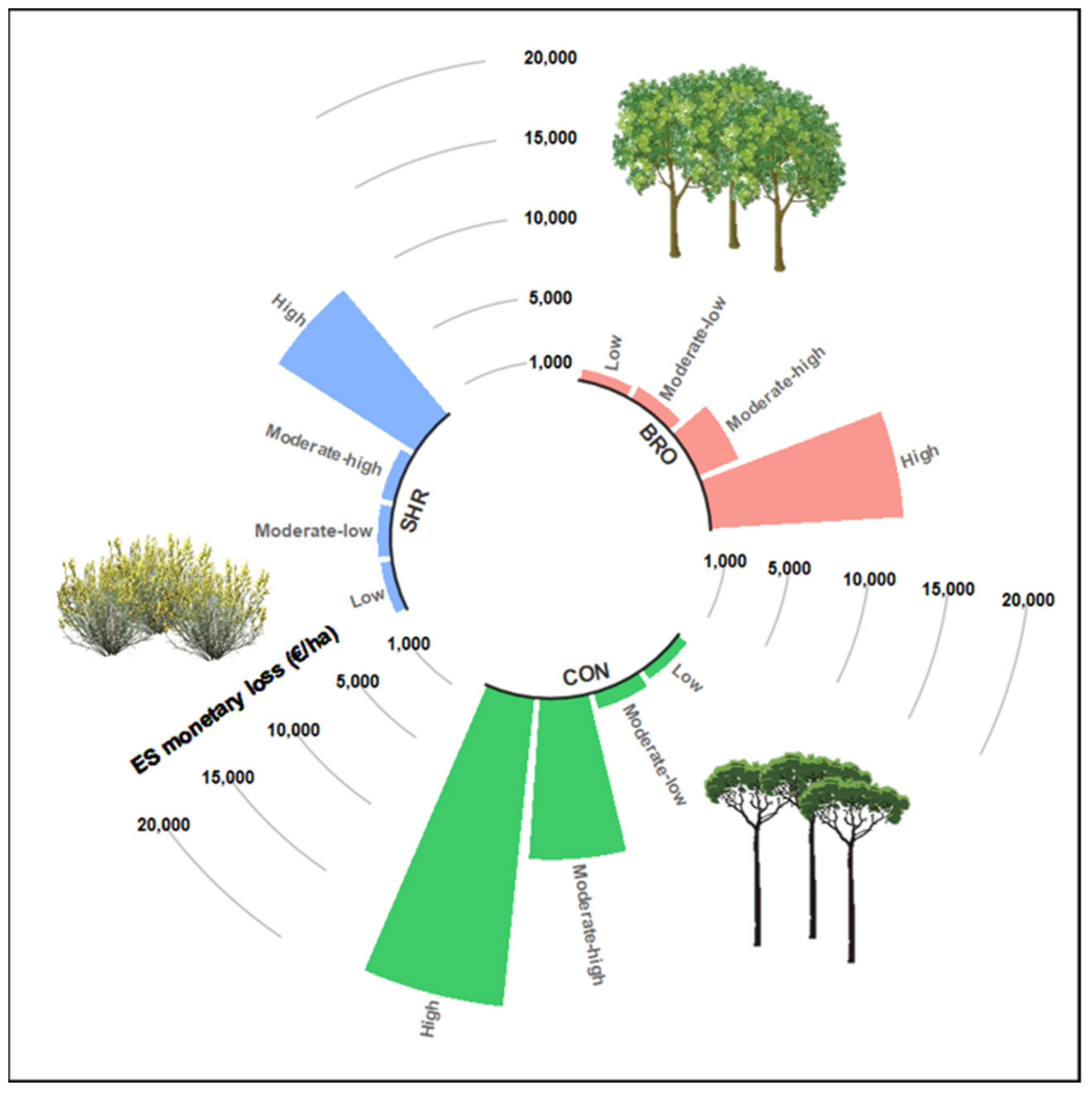
| Ecosystem Services | Short Description | Method | Recipient |
|---|---|---|---|
| Provisioning | Biomass (i.e., timber and chips) for direct use or processing | Residual value | Local bio-based industry |
| Regulation and maintenance | Control of erosion rates and habitat restoration | Replacement price | Local inhabitants |
| Pollination | Market price | Local tomato farms | |
| Carbon stock | Permit prices/Benefit transfer | Local inhabitants | |
| Cultural | Physical and experiential interactions with the natural environment | Direct-use value | Local ecotourists |
Publisher’s Note: MDPI stays neutral with regard to jurisdictional claims in published maps and institutional affiliations. |
© 2021 by the authors. Licensee MDPI, Basel, Switzerland. This article is an open access article distributed under the terms and conditions of the Creative Commons Attribution (CC BY) license (https://creativecommons.org/licenses/by/4.0/).
Share and Cite
Silvestro, R.; Saulino, L.; Cavallo, C.; Allevato, E.; Pindozzi, S.; Cervelli, E.; Conti, P.; Mazzoleni, S.; Saracino, A. The Footprint of Wildfires on Mediterranean Forest Ecosystem Services in Vesuvius National Park. Fire 2021, 4, 95. https://doi.org/10.3390/fire4040095
Silvestro R, Saulino L, Cavallo C, Allevato E, Pindozzi S, Cervelli E, Conti P, Mazzoleni S, Saracino A. The Footprint of Wildfires on Mediterranean Forest Ecosystem Services in Vesuvius National Park. Fire. 2021; 4(4):95. https://doi.org/10.3390/fire4040095
Chicago/Turabian StyleSilvestro, Roberto, Luigi Saulino, Carla Cavallo, Emilia Allevato, Stefania Pindozzi, Elena Cervelli, Paola Conti, Stefano Mazzoleni, and Antonio Saracino. 2021. "The Footprint of Wildfires on Mediterranean Forest Ecosystem Services in Vesuvius National Park" Fire 4, no. 4: 95. https://doi.org/10.3390/fire4040095
APA StyleSilvestro, R., Saulino, L., Cavallo, C., Allevato, E., Pindozzi, S., Cervelli, E., Conti, P., Mazzoleni, S., & Saracino, A. (2021). The Footprint of Wildfires on Mediterranean Forest Ecosystem Services in Vesuvius National Park. Fire, 4(4), 95. https://doi.org/10.3390/fire4040095









